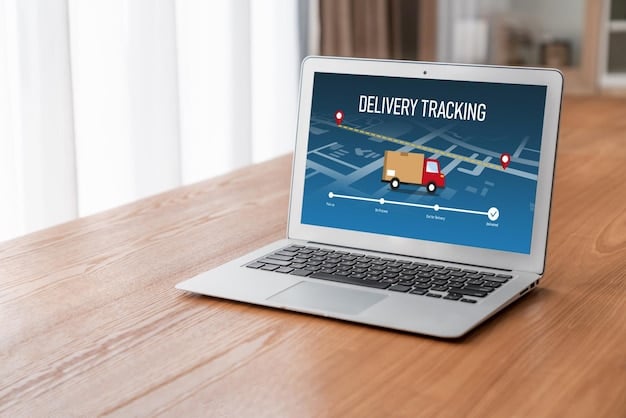Navigating USPS Rate Changes: Smart Shipping Tips for You

US Postal Service rate changes can impact your shipping costs; however, by understanding these changes and utilizing strategies like choosing the right packaging, comparing shipping options, and optimizing delivery speed, you can minimize expenses for personal use.
Navigating the ever-changing landscape of US Postal Service rate changes can feel like a daunting task. But don’t worry! This guide will equip you with the knowledge and strategies to minimize your shipping costs for personal use, ensuring you can send those packages without breaking the bank.
Understanding Recent USPS Rate Changes
The US Postal Service (USPS) periodically adjusts its rates to reflect operational costs and ensure service sustainability. Keeping abreast of these changes is crucial for anyone who frequently ships packages, whether for personal or business reasons. Let’s delve into the factors influencing these rate adjustments.
Factors Influencing Rate Adjustments
Several elements play a role in shaping USPS rate changes. These include fuel costs, transportation expenses, labor costs, and infrastructural upgrades. Additionally, the volume of mail and packages handled by the USPS impacts its operational efficiency and, consequently, its pricing strategies.
- Fuel Costs: Fluctuations in fuel prices directly affect transportation expenses, leading to rate adjustments.
- Labor Costs: Salaries and benefits for USPS employees contribute significantly to operational costs, influencing pricing decisions.
- Infrastructure Investments: Upgrades to facilities and equipment are necessary to maintain service quality, but these investments can lead to rate hikes.
- Mail Volume: Declining mail volumes and increasing package volumes necessitate adjustments in pricing to balance revenue and expenses.

Understanding these factors empowers you to anticipate potential rate changes and proactively adjust your shipping strategies. Staying informed ensures that you can minimize the impact of these changes on your personal shipping expenses.
Choosing the Right Packaging to Reduce Costs
Selecting the appropriate packaging can significantly impact your shipping costs with USPS. Using the correct size and type of packaging not only ensures the safety of your items but also helps you avoid unnecessary charges. Let’s explore different packaging options and how they can reduce expenses.
Utilizing USPS Flat Rate Options
USPS offers Flat Rate options, such as Flat Rate Envelopes, Small Flat Rate Boxes, Medium Flat Rate Boxes, and Large Flat Rate Boxes. These options allow you to ship items at a fixed rate, regardless of weight or distance, as long as they fit into the specified packaging. This can be particularly cost-effective for heavy or bulky items.
When using Flat Rate options, ensure your item fits comfortably within the packaging without bulging or distorting the box. Overstuffing a Flat Rate box can result in it being rejected or charged at a higher rate.
Recycling and Reusing Packaging Materials
Recycling and reusing packaging materials is an environmentally friendly and cost-effective approach. Instead of purchasing new boxes, consider repurposing old ones or using padded envelopes you already have. Ensure the reused packaging is in good condition and free from any old labels or markings.
- Cardboard Boxes: Break down and store cardboard boxes for future use.
- Padded Envelopes: Reuse padded envelopes for shipping smaller items.
- Packing Peanuts: Collect and reuse packing peanuts to cushion fragile items.
By carefully selecting your packaging materials and utilizing Flat Rate options, you can minimize shipping costs and contribute to sustainable practices. Properly packaged items also reduce the risk of damage during transit, saving you potential replacement costs.
Comparing USPS Shipping Options for Best Rates
The USPS provides a variety of shipping options, each with different rates and delivery times. Comparing these options is essential to find the most cost-effective solution for your specific needs. Let’s examine the various USPS services and how they compare in terms of price and speed.
Priority Mail vs. First Class Package Service
Priority Mail and First Class Package Service are two popular options for shipping packages. Priority Mail offers expedited delivery in 1-3 business days, while First Class Package Service is designed for lighter packages (under 16 ounces) with delivery in 2-5 business days. Consider the urgency of your shipment when choosing between these services.
For heavier packages or items requiring faster delivery, Priority Mail may be the better choice, despite being slightly more expensive. However, for lightweight items that don’t need immediate delivery, First Class Package Service provides a more economical option.
Retail Prices vs. Online Postage
Purchasing postage online through the USPS website or third-party providers often results in lower rates compared to buying postage at a retail location. Online postage providers may offer discounts, label printing services, and package tracking, making the process more convenient and cost-effective.

Comparing retail prices with online postage rates can reveal significant savings. Online postage allows you to avoid lines at the post office and take advantage of discounted rates, optimizing your shipping budget.
By carefully comparing USPS shipping options and leveraging online postage, you can identify the most suitable and affordable service for your packages. Assessing delivery speed requirements and package weight is crucial for making informed decisions.
Leveraging USPS Discounts and Promotions
The USPS offers various discounts and promotions to help customers save on shipping costs. Taking advantage of these opportunities can lead to substantial savings, especially for frequent shippers. Let’s look at some ways to access discounts and promotions.
Using USPS Loyalty Programs
Certain USPS loyalty programs provide discounts and benefits to regular customers. These programs may offer reduced rates, free shipping supplies, or other perks. Check the USPS website or inquire at your local post office to see if you qualify for any loyalty programs.
Participating in loyalty programs can provide ongoing savings on your shipping expenses. By enrolling in these programs, you can access exclusive discounts and benefits tailored to your shipping volume and needs.
Taking Advantage of Seasonal Promotions
USPS often runs seasonal promotions during holidays or special events, offering discounted rates or free shipping on select services. Keep an eye out for these promotions and plan your shipping accordingly to capitalize on the savings. Subscribing to the USPS newsletter or following their social media channels can help you stay informed.
- Holiday Promotions: Discounts during major holidays like Christmas, Thanksgiving, and New Year’s.
- Back-to-School Specials: Reduced rates for shipping school supplies and care packages.
- Summer Savings: Promotions aimed at increasing shipping volumes during the summer months.
By staying informed about USPS discounts and promotions, you can significantly reduce your shipping costs throughout the year. Actively seeking and utilizing these opportunities ensures that you are getting the best possible rates for your shipments.
Optimizing Delivery Speed vs. Cost
Balancing delivery speed with cost is a key consideration when shipping via USPS. Understanding the trade-offs between faster delivery and higher prices can help you make informed decisions based on your specific needs and budget. Let’s explore this balance.
When to Choose Slower Shipping Options
If your items are not time-sensitive, opting for slower shipping options like USPS Retail Ground or Media Mail can save you money. These services typically have lower rates but longer delivery times. Assess the urgency of your shipment and choose the service that best matches your timeline and budget.
Slower shipping options are suitable for non-urgent items such as books, documents, or non-perishable goods. By accepting a longer delivery time, you can significantly reduce your shipping costs.
Strategies for Expedited Shipping at Lower Costs
If you require faster delivery but want to minimize costs, consider using Priority Mail with online postage to obtain discounted rates. Combine this with Flat Rate options when they are suitable for your items. Efficient packaging and consolidation of shipments can also help reduce expenses while maintaining speed.
Expedited shipping doesn’t always have to break the bank. By leveraging online postage, Flat Rate options, and careful packaging, you can achieve faster delivery at a more affordable price.
Optimizing the balance between delivery speed and cost involves a thorough assessment of your shipping needs. Consider the urgency of your items, compare different service rates, and utilize discounted options to make the most cost-effective choice.
Tracking and Managing Your USPS Shipments
Effectively tracking and managing your USPS shipments helps you monitor their progress, anticipate delivery times, and address any potential issues promptly. Proper tracking provides peace of mind and ensures that your packages reach their destination as expected. Let’s look at strategies for tracking and managing shipments efficiently.
Using USPS Tracking Tools
The USPS offers online tracking tools that allow you to monitor the status of your shipments. Simply enter the tracking number on the USPS website to view the current location and expected delivery date of your package. Additionally, you can sign up for email or text notifications to receive updates on your shipment’s progress.
Utilizing USPS tracking tools empowers you to stay informed about your shipments. Real-time updates enable you to anticipate delivery times and respond quickly to any unforeseen issues, such as delays or misrouting.
Addressing Delivery Issues and Claims
In the event of a delivery issue, such as a lost or damaged package, promptly file a claim with USPS. Provide all relevant information, including the tracking number, proof of value, and a detailed description of the issue. USPS will investigate the claim and may provide compensation for the loss or damage.
Addressing delivery issues promptly is essential to protect your interests. Filing a claim with USPS allows you to seek resolution and potential compensation for any losses incurred due to delivery problems.
By actively tracking and managing your USPS shipments, you can effectively monitor their progress and address any potential issues in a timely manner. Utilizing USPS tracking tools and promptly filing claims ensures a smooth and reliable shipping experience.
| Key Point | Brief Description |
|---|---|
| 📦 Packaging | Use Flat Rate options or recycle materials to save on costs. |
| 🚚 Shipping Options | Compare Priority Mail vs. First Class; online postage is cheaper. |
| 💰 Discounts | Enroll in loyalty programs and watch for seasonal promotions. |
| ⏱️ Delivery Speed | Choose slower options for non-urgent items; expedite with online postage. |
Frequently Asked Questions
▼
Fuel costs, labor expenses, infrastructure investments, and fluctuations in mail and package volumes are primary drivers behind USPS rate adjustments.
▼
Opt for USPS Flat Rate boxes when possible to ship items at a fixed rate, and reuse packaging materials to reduce the need for new supplies.
▼
Priority Mail offers faster delivery (1-3 days), while First Class Package Service is cheaper but slower (2-5 days) and limited to packages under 16 ounces.
▼
Enrolling in USPS loyalty programs and keeping an eye out for seasonal promotions can provide discounts and other benefits for regular shippers.
▼
Utilize the tracking number on the USPS website or app to monitor the status of your shipment and sign up for email or text notifications for updates.
Conclusion
Understanding and adapting to US Postal Service rate changes can significantly impact your shipping expenses. By implementing the strategies discussed—such as choosing the right packaging, comparing shipping options, leveraging discounts, and optimizing delivery speed—you can minimize costs and ship smarter. Stay informed, be proactive, and take control of your shipping budget.





